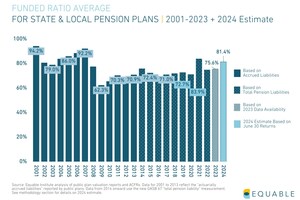Report Finds K-12 Pension Debt Costs Threaten Education Equity in Ohio
NEW YORK, Feb. 1, 2023 /PRNewswire/ -- Equable Institute and Opportunity Institute have released new research exploring the effect of teacher pension debt on education resource equity in Ohio.
The report, titled Pension Debt Challenges for Equity in Education: The Effect of Teacher Unfunded Liability Costs on K–12 Education Funding in Ohio, found that growing unfunded pension liabilities for teachers and other school employees have silently undermined Ohio' ability to improve education outcomes for students and inequitable impacts on teachers through growing costs and funding policies that disadvantage low-income communities.
"The increase in the cost of teacher retirement benefits in Ohio has been largely hidden from school districts over the past two decades, as the state has used increased teacher contributions to address STRS pension debt, along with cuts to health care resources, retiree cost-of-living adjustments, and the value of pension benefits themselves," said Equable executive director Anthony Randazzo. "But the state has run out of ways to cover the growing costs for teachers and school employees, other than to increase employer contributions. Policymakers should seriously consider whether it would be more appropriate to cover those cost increases at the state level rather than passing any future cost increases off onto schools, teachers, and the students they serve."
Specifically, the report finds:
- An increasing share of state and local K–12 education spending has been siphoned off to cover pension costs.
- Between 2001 and 2020, pension spending as a share of state and local K-12 education spending has increased by 45.5%.
- As of 2020, Ohio's school unfunded liability amounts to $18,725 per student and accounts for 77.62% of total K-12 funding per student. In 2001, unfunded liabilities accounted for 32.59% of per student funding.
- Overall education spending hasn't increased at the same rate as pension spending. This is effectively a cut to education funding that disproportionately harms low-income communities.
- Retirement benefit costs for school districts have increased at more than three times the rate of total state and local K–12 education spending over the past two decades.
- State and local K–12 education spending in Ohio increased 26.9% between 2001 and 2020, adjusted for inflation. During the same period, spending on employer retirement costs jumped 84.6%. When K-12 spending doesn't increase at the same rate as pension spending, low income districts suffer as they don't have the same ability to raise revenue through property taxes to cover the budget shortfall.
- Ohio has maxed out its use of active teachers and retirees to pay for growing retirement costs.
- Barring an extended market bull-run, unfunded liabilities will flat line at $23 billion in the best-case scenario. In a worse scenario, they could increase to nearly $50 billion by 2031, necessitating increased contribution rates.
- Currently, Members pay 14% of salary and the STRS board is no longer allocating any portion of employer contributions to the health care trust fund. The retired teachers COLA has been lowered twice, and is now at 0%. Without changing how pensions are funded relative to K-12 budgets, Ohio school districts could face significant cuts to available funding for student programs and resources to support educators.
Opportunity Institute and Equable Institute note that without changes to how public school employee retirement benefits are financed, pension debt costs will continue to exacerbate already existing education finance inequities and draw away the resources from the students who have the greatest need.
"The status quo contribution requirements from schools are already inequitably distributed such that economically disadvantaged communities pay at least a part of the retirement costs of educators earning higher salaries in wealthier districts," noted Opportunity Institute president Maria Echaveste. "If the state has to raise school district costs for retirement benefits it would exacerbate those inequities, and reduce resources for things like learning loss counselors and enrichment programs such as art and music."
This report is one of four reports detailing the impact of unique pension debt challenges facing state education budgets across the U.S. Please visit pensionequityineducation.org to download Ohio's report along with reports for California, Texas, and Florida.
Equable Institute and Opportunity Institute will be hosting webinars covering the findings of each of the reports in March 2023. Click here to sign up to be notified when registration opens.
About Opportunity Institute
The Opportunity Institute (OI) is a national education policy organization that focuses broadly on cradle-to-career education policy, practice issues, and adjacent areas of social policy. Our work bridges the domains of policy, research, advocacy, and addresses equity in three main areas of work: "Whole Child" equity; resource equity; equity indicators.
About Equable Institute
Equable is a bipartisan non-profit that works with public retirement system stakeholders to solve complex pension funding challenges with data-driven solutions. We exist to support public sector workers in understanding how their retirement systems can be improved, and to help state and local governments find ways to both fix threats to municipal finance stability and ensure the retirement security of all public servants.
SOURCE Equable Institute

WANT YOUR COMPANY'S NEWS FEATURED ON PRNEWSWIRE.COM?
Newsrooms &
Influencers
Digital Media
Outlets
Journalists
Opted In






Share this article